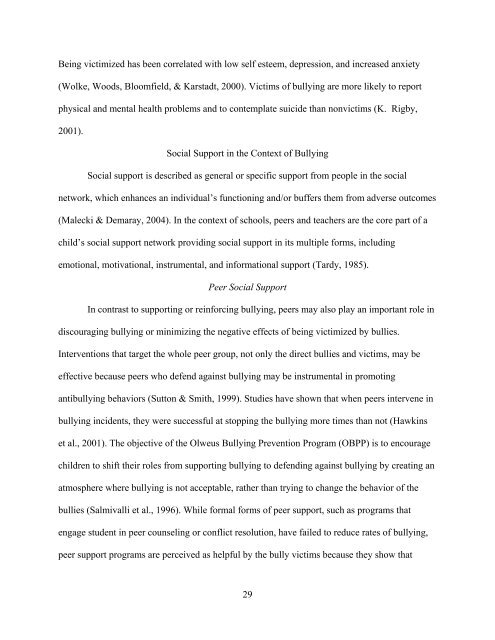Copyright Malvin Porter, Jr. 2010 - acumen - The University of ...
Copyright Malvin Porter, Jr. 2010 - acumen - The University of ...
Copyright Malvin Porter, Jr. 2010 - acumen - The University of ...
Create successful ePaper yourself
Turn your PDF publications into a flip-book with our unique Google optimized e-Paper software.
Being victimized has been correlated with low self esteem, depression, and increased anxiety<br />
(Wolke, Woods, Bloomfield, & Karstadt, 2000). Victims <strong>of</strong> bullying are more likely to report<br />
physical and mental health problems and to contemplate suicide than nonvictims (K. Rigby,<br />
2001).<br />
Social Support in the Context <strong>of</strong> Bullying<br />
Social support is described as general or specific support from people in the social<br />
network, which enhances an individual’s functioning and/or buffers them from adverse outcomes<br />
(Malecki & Demaray, 2004). In the context <strong>of</strong> schools, peers and teachers are the core part <strong>of</strong> a<br />
child’s social support network providing social support in its multiple forms, including<br />
emotional, motivational, instrumental, and informational support (Tardy, 1985).<br />
Peer Social Support<br />
In contrast to supporting or reinforcing bullying, peers may also play an important role in<br />
discouraging bullying or minimizing the negative effects <strong>of</strong> being victimized by bullies.<br />
Interventions that target the whole peer group, not only the direct bullies and victims, may be<br />
effective because peers who defend against bullying may be instrumental in promoting<br />
antibullying behaviors (Sutton & Smith, 1999). Studies have shown that when peers intervene in<br />
bullying incidents, they were successful at stopping the bullying more times than not (Hawkins<br />
et al., 2001). <strong>The</strong> objective <strong>of</strong> the Olweus Bullying Prevention Program (OBPP) is to encourage<br />
children to shift their roles from supporting bullying to defending against bullying by creating an<br />
atmosphere where bullying is not acceptable, rather than trying to change the behavior <strong>of</strong> the<br />
bullies (Salmivalli et al., 1996). While formal forms <strong>of</strong> peer support, such as programs that<br />
engage student in peer counseling or conflict resolution, have failed to reduce rates <strong>of</strong> bullying,<br />
peer support programs are perceived as helpful by the bully victims because they show that<br />
29

















